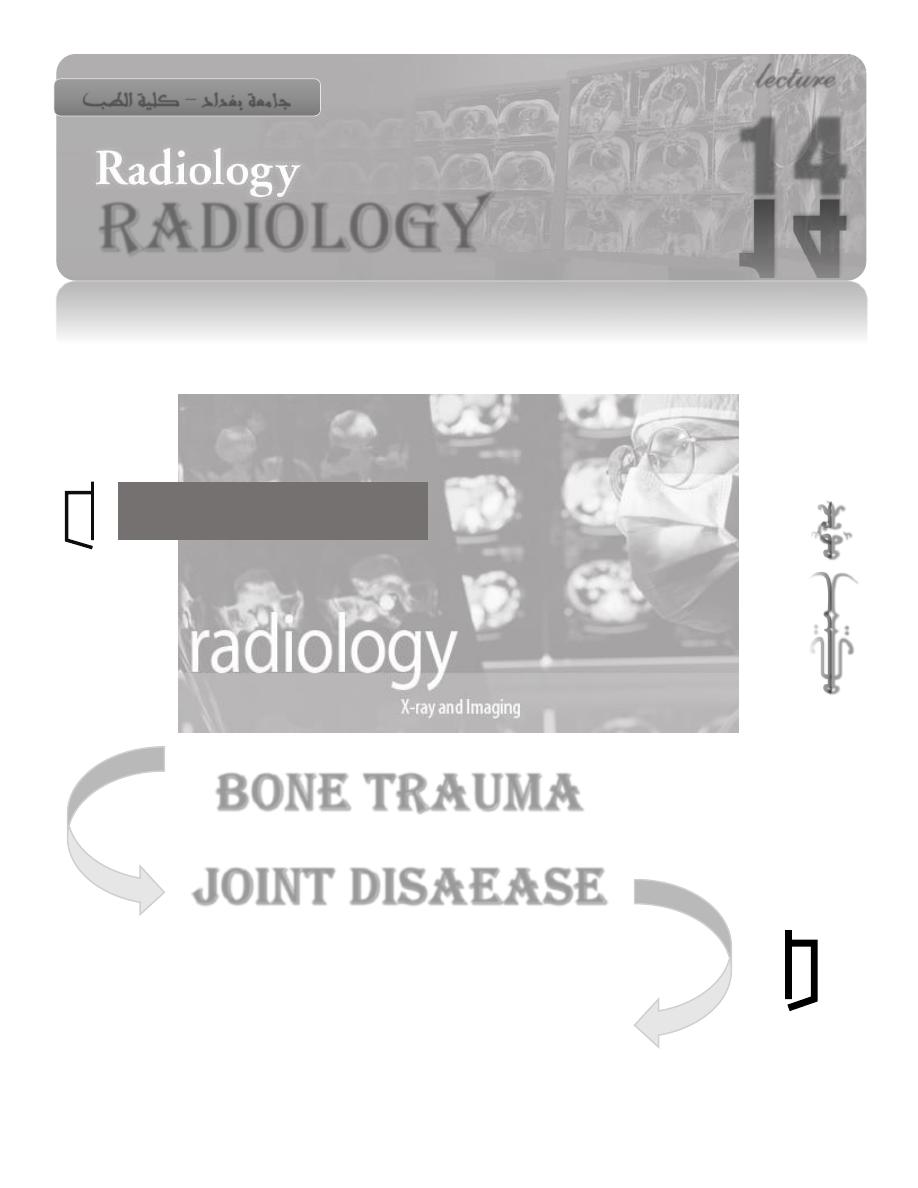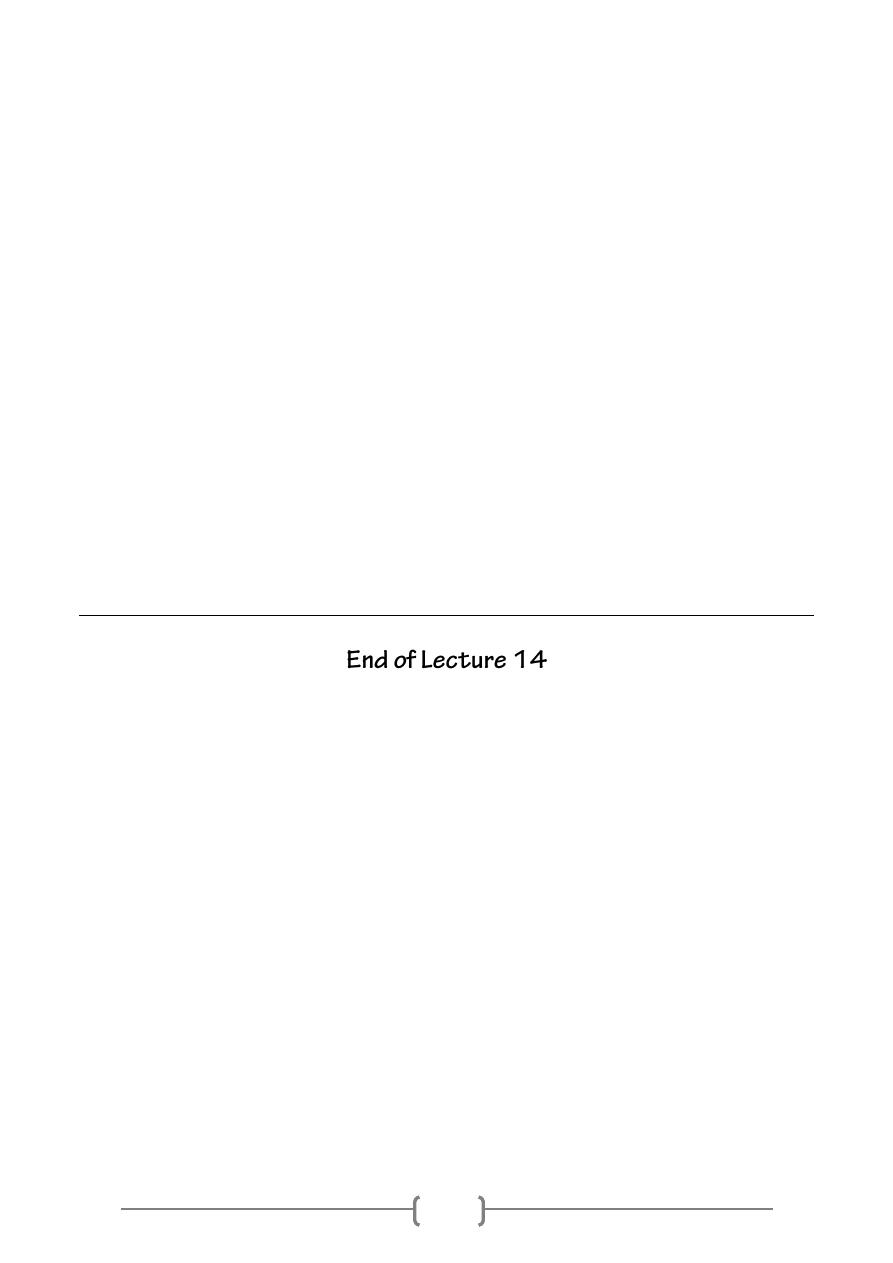
RadioLoGY
lecture
14
جامعة بغداد
–
كلية الطب
Bone trauma
Joint disaease
ؤيد
م بتكم
MUSTAFA laith
Dr Laith


Bone Trauma and Joint Disease
RADIOLOGY 14
Dr. Laith
1
Aim of the plain film
1. confirm the presence of fracture
2. decide if the bone is normal or abnormal
3. assess the position of the bone ends at the site of fracture,
displacement , impaction
4. assess healing & complications
points to be considered
1. at least two views are needed
2. some fractures can produce injuries at two sites at the same time
e.g. tibial fracture associated with fibula fracture , so should be
looked for carefully
3. comparison with the other side may be required in equivocal
cases
4. re-evaluation after 1 week is needed in some cases as suspected
scaphoid fracture
signs of fracture
1. fracture line : thin lucent line sometimes appear as dense line
from overlapping fragments
2. step in the cortex
3. interruption of the trabecular pattern .this sign is useful in
impacted fractures where there is no visible lucent line
4. buckling of the cortex important in children
5. soft tissue swelling
6. joint effusion: in the elbow joint effusion indicates underlying
fracture the fat pad lying adjacent to the joint capsule will be
displaced away from the shaft of the humerus on the lateral view
further plain film views needed:
1. different projection as the oblique view
2. stress view: important in the assessment of ligament injury
around the join e.g. eversion & inversion movements may show
movement of the talus in ankle joint injury
3. flexion-extension views of particular help in assessment of
cervical spine to show alteration of the alignment of the
posterior border of the vertebral body which is more obvious

Bone Trauma and Joint Disease
RADIOLOGY 14
Dr. Laith
2
when the neck is flexed .This test should not be carried out on
unconscious patient
Radionuclide bone scan in bone trauma
shows increase activity within 2-3 days of injury as long as bone
healing continues(many months)
multiple rib fractures give picture similar to metastases but the
distribution usually gives clue to the diagnosis
CT scan in bone trauma
useful in the assessment of complex bones as the spine , pelvis to
show fracture & displacement of the fragment into the joint
useful in the assessment of the extent of soft tissue injury & internal
organ injury
less manipulation of the pt. required
MRI in bone trauma
the fracture line appear as low signal within the high signal of the
bone marrow on T1 image
alteration in the signal of bone marrow in case of bone bruise &
hemorrhage
useful in soft tissue injuries
Specific types of fracture
Stress fracture: results from minor repeated trauma as March fracture
that affect the shaft of the metatarsals & tibia & fibula. Initially no
fracture line, later on fracture line appears with periosteal reaction
then a band of sclerosis around the bone will develop. Radionuclide
scanning is useful to distinguish stress fracture from other causes of
pain shown as area of increased uptake before changes are visible on
plain radiograph.
Insufficiency fractures: results from normal activity or minor trauma
in weakened bone commonly from osteoporosis or osteomalacia.
Compression fracture of the vertebra are commonest examples

Bone Trauma and Joint Disease
RADIOLOGY 14
Dr. Laith
3
Salter-Harris fractures: fractures of the growth plate & metaphysis of
long bones often occur in children & may lead to subsequent growth
deformities because of damage to growth plate.
pathological fracture: the causative pathology is usually apparent as
Paget`s disease , primary or secondary bone tumors
Non-accidental injury (Battered baby syndrome)
if child abuse is suspected the whole skeleton should be surveyed
1. multiplicity of the fracture this is an important sign particularly
if seen in different stages of healing
2. metaphyseal fractures seen as small chips of bone from the
metaphysis of the long bone
3. epiphyseal separation
4. Fractures of the ribs.
5. metaphyseal sclerosis from repeated trauma & repair
6. periosteal reaction due to bleeding under the periosteum
radionuclide bone scan is used to detect the site of bone & joint injury
,
CT & US used in suspected brain injury
Imaging Modalities
1-plain x ray:
2-MRI: gaining increasing importance in the assessment of joint diseases
particularly in ligament injury , meniscal tear & AVN
3-Arthrography: injection of contrast medium in the joint space , it has
been largely replaced by MRI
Plain film signs of joint disease
articular cartilage, synovium , synovial fluid & capsule are of the same
radiodensity as the soft tissues therefore can not be appreciated as discrete
structures

Bone Trauma and Joint Disease
RADIOLOGY 14
Dr. Laith
4
signs pointing to the presence of arthritis
1. joint space narrowing: due to destruction of the articular cartilage .It
occurs in all types of arthritis excerpt AVN
2. Soft tissue swelling seen when there is periarticular inflammation &
joint effusion. Discrete soft tissue swelling occur in gout
3. osteoporosis due to hyperemia & disuse. It is particularly severe in
RA & TB arthritis
signs pointing to the cause of arthritis
1-articular erosions: destruction of the articular cortex & adjacent
trabecular bone usually associated with destruction of the articular cartilage
Causes of erosions:
(a) inflammatory overgrowth of synovium (pannus) that occur in RA ,
juvenile RA , psoriasis , Reiter's disease , ankylosing spondylitis , TB
arthritis
(b) response to deposition of urate crystals in gout
(c) destruction caused by infection
(d) synovial overgrowth due to repeated hemorrhage as in hemophilia
(e) neoplastic overgrowth of synovium as in synovial sarcoma
2-osteophytes, subchondral sclerosis & cysts: these are features of OA
.Increased density of subchondral bone seen also in AVN
3-alteration in the shape of the joint seen in slipped capital epiphysis,
CDH, osteochondritis dissecans & AVN
Approach to the Diagnosis of arthritis
1-multiplicity of joint affection: solitary joint involvement points to
infection or synovial tumor while multiple involvement indicates systemic
condition as RA & psoriasis
2-site of arthritis: certain arthropathies tend to have predilection for specific
joints

Bone Trauma and Joint Disease
RADIOLOGY 14
Dr. Laith
5
(a) RA almost invariably affect the hands & feet principally the metacarpo-
& metatarsophalangeal joints , the proximal IPJ & the wrist joint
(b) psoriatic arthropathy: affect distal IPJ
(c) gout: characteristically involves the metatarsophalangeal joint of the big
toe
(d) OA: affect knee & hip joints & rarely the shoulder , ankle , wrist joints
.When affecting the hands it is almost always affecting the distal IPJ &
often the CMJ of the big toe. In the feet it is almost always in the MPJ of
the big toe
(e) neuropathic arthropathy: distribution depends on the pathology, in DM
it affect feet , in syringomyelia it affect shoulders , elbow & wrist joints
3-presence of systemic disease: arthritis may be part of other diseases e.g.
DM & hemophilia
RHEUMATOID ARTHRITIS
The commonest erosive arthropathy. the detection of widespread erosive
arthritis is almost diagnostic of RA
the role of X ray is to assist in the diagnosis in doubtful cases , assess the
extent of the disease & to monitor the response to treatment
early findings in RA:
1-fusiform periarticular soft tissue swelling & osteoporosis: these are the
earliest changes
2-joint space narrowing resulting from destruction of the articular cartilage
by the pannus
3-small bony erosions at the margin of the joint seen at the metatarso &
metacarpophalangeal joints, proximal IPJ & styloid process of ulna
4-advanced changes are the wide spread erosions with disruption of the
joint surface, may progress to very severe destruction resulting in arthritis
mutilans
5-ulnar deviation
6-subluxation at the atlantoaxial joint(> 2.5 mm between odontoid peg &
anterior arch of atlas ) due to laxity of the ligaments ,lateral X ray with the
neck flexed may be required to demonstrate the lesion , however it's well
seen on MRI
7-resorption of distal ends of the clavicle
8-erosion of the superior margins of the posterior portions of 3-5
th
ribs

Bone Trauma and Joint Disease
RADIOLOGY 14
Dr. Laith
6
9-destruction & narrowing of the disc spaces, irregular vertebral body
outlines without osteophytosis
Other Erosive Arthropathies
Juvenile RA:
(a) the erosions are less extensive than in RA. Erosions affect the hips,
knee , wrist & ankle joints.
(b) periostitis & bone ankylosis of the carpal bones, sacroiliac joints &
cervical spines
(c) subluxation of atlantoaxial joint
(d) Epiphyseal enlargement with premature fusion result in growth
disparity & deformity
Reiter's arthropathy:
(a) knee , ankle & feet joints are commonly affected by joint space
narrowing
(b) calcaneal spur
(c) fluffy periosteal reaction at the metatarsal neck , proximal phalanges ,
tibia , fibula
(d) osteoporosis develop late in the course of the disease
(e) bilateral sacroiliac joints involvement (erosion & ankylosis )
Psoriatic arthropathy :
(a) Sausage like swelling of the entire digit
(b) Asymmetrical destruction of the DIPJ
(c) Destruction of the interphalangeal joint of the big toe with extensive
periosteal reaction at the base of the distal phalynx (pathognomonic)
(d) Ivory phalynx: sclerosis of terminal phalynx
(e) Squaring of the vertebrae with apophyseal joint narrowing & sclerosis
(f) Atlantoaxial subluxation
(g) Unilateral asymmetrical sacroiliitis ( widening , sclerosis , fusion )

Bone Trauma and Joint Disease
RADIOLOGY 14
Dr. Laith
7
GOUT
1. soft tissue swelling occur early
2. Bony erosions occurring some distance from the articular cortex.
These erosions are well defined with sclerotic margins & frequently
have overhanging edge
3. no osteoporosis
4. tophi are soft tissue swelling due to deposition of urate crystals in
periarticular position , they may show calcification
PYOGENIC ARTHRITIS
1-caused by staph. Aureus by hematogenous spread or from adjacent OM.
Hip &knee joints frequently affected
2-early radiograph is normal
3-soft tissue swelling is the first sign to appear
4-destruction of the articular cartilage with narrowing of joint space
5-articular cortex erosion with destruction of the subchondral bone
6-reactive bone sclerosis may occur
7-poor healing resulting in ankylosis
TUBERCLOUS ARTHRITIS
1-spred from adjacent OM, Hip & knee joints commonly affected
2-extensive juxta articular osteoporosis
3-marginal erosion with very slow loss of joint space
4-soft tissue in the acute stage is normal
5-healing by varying sclerosis & extensive soft tissue calcification
HEMOPHILIA
1-repeated hemorrhage into the joint results in soft tissue swelling , erosion
, & subchondral cyst formation
2-in the knee joint deep intercondylar notch is characteristic
OSTEOARTHRITIS
commonest type of arthritis encountered
affect weight bearing joints as the hip & knee. Other joints frequently
affected are the wrist & the first metatarsophalangeal joint. Ankle joint is
rarely affected

Bone Trauma and Joint Disease
RADIOLOGY 14
Dr. Laith
8
findings:
1. narrowing of the joint space which is maximum at the weight bearing
portion of the joint , in the hip it’s the superior aspect of the joint & in
the knee it’s the medial aspect of the joint
2. osteophytes seen as bony projections occurring at the articular margin
3. subchondral sclerosis occurring on both sides of the joint but worse on
one side
4. subchondral cyst :occurring beneath the articular cortex often in
association with sclerosis. The cysts are easily distinguished from as
they lie beneath the intact cortex & have sclerotic margin erosions ,
however when there is crumbling of the articular surface the
differentiation become difficult
5. loose bodies :these are discrete pieces of calcified cartilage or bone lying
freely within the joint most frequently seen in the knee
Neuropathic joint
sever form of degenerative bone disease
In syringomyelia the shoulder & elbow joints are commonly affected . In
Tabes dorsalis the knee joint is affected .There is complete
disorganization with variable sclerosis of the bone
In DM pt with peripheral neuropathy & in leprosy the feet affected with
extensive resorption of the bone ends, with disorganization of the joint.
Calcification of the arteries commonly seen in diabetic pt..
Comparison between OA & RA
OA
RA
Joint
space
narrowing
maximum at weight bearing
sites
Erosion do not occur but
crumbling of the joint surface
mimic erosion
Subchondral sclerosis & cysts
seen
Sclerosis is prominent feature
No osteoporosis
Joint space narrowing is
uniform
Erosions are characteristic
features
Not a feature but erosion en
face mimic cyst
Sclerosis is not a feature
unless there is secondary OA
Osteoporosis often present

Bone Trauma and Joint Disease
RADIOLOGY 14
Dr. Laith
9
Chondrocalcinosis
Definition : calcification of the articular cartilage
Knee joint frequently affected due to deposition of calcium
pyrophosphate crystals in the cartilage .The condition is called
pseudogout due to close clinical resemblance to gout. Sometimes it is
asymptomatic
Feature of sever degenerative disease seen
Synovial Sarcoma
Slowly growing expansile malignant tumor arising from synovial
lining , bursa , tendon sheet .Uncommon intra articular
Knee joint is most commonly affected
Well defined spherical soft tissue mass adjacent to the joint with
peripheral calcification
Bone involvement in the form of periosteal reaction, remodeling,
invasion of the cortex with ill defined destruction & juxta articular
osteoporosis
Avascular Necrosis
Commonly affects the intra articular portion of the bone
Causes :
1-steriod therapy
2-collagen vascular disease
3-SCA
4-exposure to high pressure environment as in deep sea divers
5-fracture: results in interruption of the blood supply ,commonly seen in
subcapital fractures of the femoral neck & scaphoid waist fractures .The
femoral head & proximal pole of the scaphoid become fragmented &
dense
MRI is the modality of choice to reach & confirm the diagnosis
1- early AVN (a) decrease contrast enhancement (b)low signal intensity
band on T1 (c) double line sign on T2 :inner high signal intensity
band surrounded by outer low signal band
2- late AVN: (a) large area of reduced signal on T1 (b)variable
appearance on T2 (c)contrast enhancement of the interface &
surrounding bone

Bone Trauma and Joint Disease
RADIOLOGY 14
Dr. Laith
10
Radionuclide scanning using radiocolloid is less sensitive than MRI
.In early stage there is photopenic are , in late stage Doughnut sign
seen (peripheral increased uptake due to capillary revascularization
with central photopenia )
X ray :
1-increased radiodensity of the subchondral bone
2-irregularity of the articular contour or even fragmentation
3-crescent lucent band seen just beneath the articular cortex
(characteristic) affected bone
4-joint space is usually preserved unless secondary OA changes develop
Osteochondritis
Definition :a group of conditions in which no definite cause for
Avascular necrosis is found
Perthe`s disease :AVN of the femoral head in children
1-the early changes are increased density & flattening of the femoral
epiphysis which progress later to collapse & fragmentation
2-widening of the epiphysis & enlargement of the femoral neck that may
show small cysts
3-widening of the joint space
with healing the femoral epiphysis reforms but may remain permanently
flattened
Freiberg`s disease: AVN of metatarsal heads
Kohler`s disease: AVN of navicular bone of the foot
Osgood Schlatter`s disease : AVN of tibial tuberosity
Keinbock`s disease : AVN of the lunate bone
Osteochondritis dissecans :localized form of AVN, the knee joint is
the most frequent site .A small fragment of bone become separated
from the articular surface leaving a defect & the fragment can often
be detected lying within the joint space. CT & MRI are excellent in
showing the loose fragment & the defect in the articular surface
Slipped capital epiphysis
Age: 8-17 yrs overweight boys
Unilateral usually , 1/3 bilateral
Early signs: widening of the epiphysis with irregularity & blurring of
the margin

Bone Trauma and Joint Disease
RADIOLOGY 14
Dr. Laith
11
Later signs : small epiphysis due to posterior slipping best
appreciated on the lateral film .When slipping is severe it shows
down ward displacement as well so can be seen of frontal projection
.In chronic slip there is irregularity with sclerosis
Complications: AVN , OA, limb shortening due to early closure of
epiphysis
Congenital dislocation of the hip
An abnormally lax joint capsule allows the femoral head to fall out of
the acetabulum .Predisposing factors are abnormal ligament laxity &
acetabular dysplasia in which there is increased acetabular angle &
shallow acetabular fossa
MALE :FEMALE =1:6
Lt. hip commonly affected (70%), bilateral in 5%
US findings: commonly used nowadays .Less than 50% of the
femoral head covered by the acetabulum (normally more than 50%)
Radiographic finding
1-superolateral displacement of the femoral head
2-increased acetabular angle
3-small capital femoral epiphysis
4-femoral head located lateral to the Perkin`s line (perpendicular line drawn
through the center of femoral shaft on frontal projection)
5-acetabular sclerosis
6-shallow acetabulum
7-delayed ossification of the femoral epiphysis
Scleroderma
Resorption of the tufts of the distal phalangeas (acrosteolysis)
Soft tissue calcification & atrophy
Internal derangement of the Knee
MRI is excellent in showing the internal anatomy of the knee joint as
the meniscus appear of low signal intensity in comparison with the
articular cartilage.
MRI advantages over arthroscopy :
1- MRI can show the joint as well as the adjacent structures
2- Can show tear that are missed occasionally on arthroscopy

Bone Trauma and Joint Disease
RADIOLOGY 14
Dr. Laith
12
3- Comfortable for the patient
Shoulder rotator cuff degeneration
MRI shows increased signal within the low signal supraspinatus
tendon
In severe or total tear there is discontinuity of the tendon with
retraction of the ends
US occasionally used
X ray may show extensive calcification on the frontal projection
adjacent to the greater tuberosity
Arthrography used in some centers by needling the joint & injecting
contrast & monitor for extravasation
